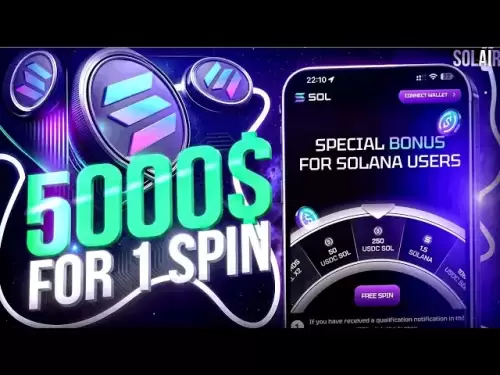-
 Bitcoin
Bitcoin $119,161.9671
1.52% -
 Ethereum
Ethereum $2,995.0722
2.34% -
 XRP
XRP $2.8555
5.32% -
 Tether USDt
Tether USDt $1.0002
0.00% -
 BNB
BNB $692.9308
1.48% -
 Solana
Solana $162.9611
1.87% -
 USDC
USDC $0.9999
0.00% -
 Dogecoin
Dogecoin $0.2014
2.84% -
 TRON
TRON $0.3032
0.90% -
 Cardano
Cardano $0.7464
6.51% -
 Hyperliquid
Hyperliquid $49.1533
5.71% -
 Stellar
Stellar $0.4773
24.77% -
 Sui
Sui $3.4979
3.93% -
 Chainlink
Chainlink $15.8552
6.01% -
 Hedera
Hedera $0.2401
23.85% -
 Bitcoin Cash
Bitcoin Cash $510.0474
0.97% -
 Avalanche
Avalanche $21.5550
4.82% -
 UNUS SED LEO
UNUS SED LEO $9.0389
-0.47% -
 Shiba Inu
Shiba Inu $0.0...01340
2.27% -
 Toncoin
Toncoin $2.9910
0.62% -
 Litecoin
Litecoin $96.4406
4.34% -
 Polkadot
Polkadot $4.0359
4.59% -
 Monero
Monero $338.4759
2.80% -
 Uniswap
Uniswap $8.6460
4.01% -
 Dai
Dai $0.9999
0.00% -
 Ethena USDe
Ethena USDe $1.0007
0.03% -
 Pepe
Pepe $0.0...01254
3.26% -
 Bitget Token
Bitget Token $4.3969
0.79% -
 Aave
Aave $312.2641
3.98% -
 Bittensor
Bittensor $397.0731
4.17%
What is the dev fee in mining software?
The dev fee in mining software allocates a small percentage of rewards to developers, typically 1–2.5%, supporting ongoing maintenance and development while keeping the software free for users.
Jul 14, 2025 at 09:07 am

Understanding the Dev Fee in Mining Software
The dev fee, short for developer fee, is a built-in mechanism in many cryptocurrency mining software applications that automatically allocates a percentage of mining rewards to the developers or maintainers of the software. This practice allows developers to generate income from their work without charging users directly, ensuring continued development and support.
In most cases, this fee is implemented by temporarily redirecting a portion of your mining hashrate to a developer-controlled wallet address during a mining session. The duration and frequency of this redirection are typically pre-set within the software code.
Dev fees usually range between 1% and 2.5%, though they can vary depending on the specific mining application and its licensing model.
Why Do Mining Software Developers Implement Dev Fees?
Developing and maintaining mining software is a continuous effort that involves optimizing performance, fixing bugs, supporting new hardware, and adapting to changes in blockchain protocols. Given the open-source nature of many mining tools, developers often rely on dev fees as a sustainable funding source.
Instead of using intrusive advertisements or charging license fees, developers prefer integrating a small percentage-based cut into the mining process itself. This ensures that users can access high-quality software without upfront costs, while contributors receive fair compensation for their efforts.
- Support ongoing maintenance and updates
- Fund future feature development
- Encourage community contributions and testing
This model benefits both developers and miners, especially when the fee is transparent and reasonable.
How Is the Dev Fee Implemented in Mining Software?
Most mining software integrates the dev fee through a hardcoded configuration that periodically redirects hashing power to a predefined wallet address. For example, some programs like XMRig or Claymore’s Dual Miner include this functionality with clear documentation in their source code and release notes.
Typically, the dev fee runs for a few seconds every few minutes. During this time, the miner will stop submitting shares to the user’s pool and instead submit them to the developer's designated pool or wallet.
For instance, a 2% dev fee may mean that the miner works for the developer for 2 seconds out of every 100 seconds.
Some advanced users attempt to bypass these fees by modifying the source code or using third-party forks, but doing so may violate the software’s license agreement and remove official support.
Common Examples of Mining Software with Dev Fees
Several popular mining applications implement dev fees as part of their monetization strategy:
- XMRig: Known for mining Monero (XMR), XMRig offers a version with and without dev fees. The dev-enabled version supports the project financially.
- Claymore’s Dual Miner: This Ethereum (ETH) and Zcash (ZEC) miner includes a 2% dev fee that activates every 30 minutes for about 6 seconds.
- PhoenixMiner: A lightweight Ethereum miner that uses a 0.5% dev fee, making it one of the lowest among competitors.
Each of these examples demonstrates how developers balance usability and financial sustainability through carefully calculated fee structures.
How to Identify and Monitor Dev Fees in Your Mining Setup
If you're running mining software that includes a dev fee, it's essential to be aware of its impact on your overall profitability. Most mining logs will display messages indicating when the dev fee is active.
To monitor the dev fee:
- Check console output or log files for terms like “Developer donation” or “Switching to dev pool”
- Use mining management tools like Awesome Miner or Minerstat that track dev fee activity across multiple rigs
- Review the software’s official documentation or GitHub repository for details on dev fee implementation
By keeping an eye on these indicators, miners can better understand how much hashing power is being allocated to the dev fee and adjust expectations accordingly.
Frequently Asked Questions
Q: Can I disable the dev fee in mining software?
A: Some open-source mining tools allow users to compile versions without dev fees, but doing so may breach licensing agreements or void support. Always review the software’s license before attempting modifications.
Q: Are dev fees considered ethical in the crypto mining community?
A: Opinions vary. Many users appreciate the transparency and support the concept of voluntary contributions. However, others argue that any hidden use of computational resources should be clearly disclosed and optional.
Q: Do all mining software applications have dev fees?
A: No. While many popular miners include dev fees, there are also fully open-source alternatives that operate without them. These are often maintained through donations or community funding platforms.
Q: How do dev fees affect mining profitability?
A: A 2% dev fee means approximately 2% less hash rate directed toward your wallet over time. Depending on your setup and hashrate, this can result in a noticeable reduction in daily earnings, especially at scale.
Disclaimer:info@kdj.com
The information provided is not trading advice. kdj.com does not assume any responsibility for any investments made based on the information provided in this article. Cryptocurrencies are highly volatile and it is highly recommended that you invest with caution after thorough research!
If you believe that the content used on this website infringes your copyright, please contact us immediately (info@kdj.com) and we will delete it promptly.
- UK Treasury Watch: Bitcoin Surge Lifts Companies Amidst Crypto Optimism
- 2025-07-14 16:30:12
- Finnovex South Africa 2025: Innovation and Expanding Inclusion in the Digital Finance Era
- 2025-07-14 16:30:12
- Pumpfun's $500M ICO: Memecoin Mania or the Future of Funding?
- 2025-07-14 14:30:12
- Dogecoin, XRP Price, and the Bitcoin Bull Run: What's the Hype?
- 2025-07-14 16:10:12
- Pump.fun's $PUMP Token Sale: A Wild Ride in the Memecoin Frenzy
- 2025-07-14 14:30:12
- Bitcoin Blasts Past $120,000 on Coinbase: All-Time Highs and What's Driving the Surge
- 2025-07-14 14:50:12
Related knowledge

How are crypto mining profits taxed?
Jul 14,2025 at 12:28am
Understanding Cryptocurrency Mining and TaxationCryptocurrency mining involves validating transactions on a blockchain network and earning rewards in ...

How to keep a mining rig cool
Jul 12,2025 at 01:42pm
Understanding the Importance of Cooling in Mining RigsCryptocurrency mining is an intensive process that places heavy demand on hardware components, p...

How much does it cost to start crypto mining?
Jul 13,2025 at 12:22am
Understanding the Basic Costs of Crypto MiningStarting crypto mining involves several upfront and ongoing expenses. The primary costs include hardware...

What is the most profitable crypto to mine?
Jul 13,2025 at 07:00am
Understanding Mining Profitability in CryptocurrencyWhen evaluating the most profitable crypto to mine, it's essential to consider several factors tha...

What do I need to start mining crypto?
Jul 13,2025 at 12:28am
Understanding the Basics of Crypto MiningCrypto mining is the process by which transactions are verified and added to a blockchain, and new coins are ...

How does crypto mining work?
Jul 13,2025 at 11:01am
Understanding the Basics of Crypto MiningCrypto mining is the process through which new cryptocurrency coins are introduced into circulation and trans...

How are crypto mining profits taxed?
Jul 14,2025 at 12:28am
Understanding Cryptocurrency Mining and TaxationCryptocurrency mining involves validating transactions on a blockchain network and earning rewards in ...

How to keep a mining rig cool
Jul 12,2025 at 01:42pm
Understanding the Importance of Cooling in Mining RigsCryptocurrency mining is an intensive process that places heavy demand on hardware components, p...

How much does it cost to start crypto mining?
Jul 13,2025 at 12:22am
Understanding the Basic Costs of Crypto MiningStarting crypto mining involves several upfront and ongoing expenses. The primary costs include hardware...

What is the most profitable crypto to mine?
Jul 13,2025 at 07:00am
Understanding Mining Profitability in CryptocurrencyWhen evaluating the most profitable crypto to mine, it's essential to consider several factors tha...

What do I need to start mining crypto?
Jul 13,2025 at 12:28am
Understanding the Basics of Crypto MiningCrypto mining is the process by which transactions are verified and added to a blockchain, and new coins are ...

How does crypto mining work?
Jul 13,2025 at 11:01am
Understanding the Basics of Crypto MiningCrypto mining is the process through which new cryptocurrency coins are introduced into circulation and trans...
See all articles

























































































